The ultimate S/4HANA Migration Phase Zero Guide
SAP customers everywhere know they can’t stay on ECC forever. Support deadlines are looming, and the pressure to move to S/4HANA isn’t going away.
But deciding how, when, and why to move isn’t as simple as flipping a switch—especially when the stakes are high, and the costs are eye-watering.
That’s where SAP Phase Zero comes in.
By reading this guide you’ll discover what phase zero is, why it matters to your S/4HANA program, how you can run a phase zero of your own, and the skills and support you’ll need to do it successfully.
1. What is Phase Zero of an SAP S/4HANA program?
So first things first – what do we mean when we talk about Phase Zero on an S/4HANA program?
A good way to think of it is as the stage before you jump into to your S/4HANA program with both feet.
It’s that breathing space where you move from feeling overwhelmed and bombarded by SAP sales decks and conflicting advice to getting real clarity about what you’re about to take on and the outcomes you want to achieve.
Before you spend millions on SAP licenses or sign up with an SI, Phase Zero helps you figure out what you have, what you need, and what you want your future to look like.
It’s where you get your ducks in a row, align your stakeholders, and map out your plan so you can step into your program with confidence, not chaos.

How does SAP Phase Zero differ from typical pre-project planning?
At this point you might be thinking “you’re just talking about program planning – we do that already”. But Phase Zero is different to your typical SAP program plan.
Typical pre-project planning is often about building timelines, budgets, and resource plans for a project you’ve already decided to do.
SAP Phase Zero is different.
It’s about stepping back and asking:
“Are we doing the right project?”
“Are we clear on why we’re doing it?”
“Do we truly understand our starting point, and are we aligned on where we want to go?”
It’s a chance to zoom out before you zoom in, so you can enter your S/4HANA programme with a clear approach that’s aligned to your business strategy to deliver what your business needs from ERP.
It’s the difference between rushing to build something and making sure you’re building the right thing, the right way, for the right reasons.
Book your S/4HANA Masterclass
Everything you wanted to know about S/4HANA migration but were to afraid to ask...Why you need indepedent Phase Zero advice
If you’ve spoken to three different advisors about Phase Zero, you’ve probably heard three different definitions. And that’s not your imagination—it’s because who you ask shapes the answer you get.
- SAP might frame Phase Zero around accelerating a move to their cloud products.
- Big SIs might include a detailed system design in their phase zero, and try to lock you into their delivery methodology.
- Independent consultancies view Phase Zero as an opportunity to understand what you have today, and the functionality you need in a future system – regardless of the software provider or SI you choose.
Add in regional nuances, local market pressures, and cultural differences around decision-making, and it’s no wonder Phase Zero can feel like a moving target.
Understanding these perspectives helps you see through the noise and shape a Phase Zero that’s right for your business—not just your suppliers.

2. Why does SAP Phase Zero matter?
There’s an argument to be made that Phase Zero is the most important phase of your S/4HANA migration project.
Skipping SAP Phase Zero might feel like a way to save time and money, but it might end up costing you far more down the road. In fact our experience with clients suggests every $1 spent during Phase Zero could be worth as much as $50 during on your actual program.
Without Phase Zero, you may find yourself diving into an S/4HANA program with unclear objectives, unrealistic budgets, and misaligned expectations across the business.
Time and again we see SAP customers get pulled into sales-led timelines, commit to licensing before understanding what they actually need, and end up with an SI in control of the direction of their SAP program and future system.
It’s like starting a marathon without training, hoping you’ll figure it out along the way—and often, that’s where costly change requests, timeline extensions, and value dilution creep in.
SAP Phase Zero gives you the space to slow down so you can speed up later, reducing rework, protecting budgets, and ensuring you’re moving for the right reasons—not just because of a looming support deadline.
A strategic model for change through S/4HANA migration
It’s no secret that moving to SAP S/4HANA is complex.
There’s technical debt, legacy processes, licensing confusion, and a constant wave of conflicting advice from SAP, SIs, and the market.
For many organisations, this complexity breeds fear: fear of making the wrong decisions, fear of overspending, fear of disruption, and fear of failure.
This fear often leads to decision paralysis, where businesses know they need to move but can’t figure out where to start, what to prioritise, or who to trust.
SAP Phase Zero helps cut through that noise. It creates the space to slow down, break the complexity into manageable parts, and build clarity about your current state, your future goals, and the right path forward.
It’s the antidote to fear-led paralysis, turning confusion into confidence so you can move forward deliberately rather than reactively.

3. Framing the business case during S/4HANA migration
Building a business case for S/4HANA isn’t just a checkbox exercise before securing funding. It’s the anchor for your transformation, ensuring the investment is tied to real business value, not just technical necessity.
Yet too often, organisations approach the business case for S/4HANA as an afterthought.
It becomes a rushed task to justify a decision that’s already been made or a compliance exercise driven by a looming ECC support deadline.
Phase Zero enables you to approach this differently, making the business case a central thread that aligns stakeholders, clarifies purpose, and drives informed decision-making from the outset.
Why framing your SAP business case early matters
At this stage, your business case is not about locking down ROI calculations to the nearest decimal point.
It’s about creating clarity on why a move to S/4HANA should happen in the first place and how it aligns with your organisation’s strategic goals.
This involves:
- Identifying business drivers: What problems or opportunities are pushing your organisation towards S/4HANA? These could include growth ambitions, operational inefficiencies, risk reduction, or the need to improve customer experience.
- Clarifying strategic alignment: How does the move to S/4HANA support your broader strategy? Does it enable expansion, innovation, agility, or new business models?
- Defining principles and priorities: What will guide investment decisions during your transformation? For example, prioritising standardisation and simplification, leveraging cloud where it makes sense, or focusing on customer-centric processes.
- Building leadership alignment: Ensuring your C-suite and business leaders understand why this move matters, what outcomes are expected, and how it will impact their areas.
By framing your business case early, you set the tone for Phase Zero as a business-led initiative, not a technical project driven by fear of support deadlines.


Create a business case narrative, not just the numbers
Early in Phase Zero, your business case is about shaping a compelling narrative that connects technology investment to meaningful business outcomes.
This means telling a clear story about why your current state is no longer sustainable, describing the future your business wants to create, and explaining the role technology will play in making that future possible.
It involves acknowledging the risks of inaction, not just the benefits of change, and painting a clear picture of what 'good' will look like for your business after the transformation.
This narrative evolves throughout Phase Zero as you deepen your understanding of your current state and refine your future vision, ensuring your team collects the right data and engages stakeholders with a clear, motivating 'why' that can be quantified later.
And this narrative doesn’t have to mention SAP or S/4HANA at all. It’s about exploring what the future will look like in your industry, and understanding what each function need to stay competitive and future thinking – regardless of software vendor.
Avoiding fear-driven business cases
One of the biggest risks with S/4HANA business cases is letting the deadline drive the decision. While the ECC support deadline is a reality, moving to S/4HANA should be positioned as a proactive, strategic choice rather than a compliance-driven panic move.
Phase Zero creates the conditions to move from “we have to” to “we want to,” by connecting the business case to outcomes that matter and ensuring your teams see the move as an opportunity to transform, not just a technical lift-and-shift.
In our experience, companies that try to create a business case purely to align to SAP’s end of support deadline struggle to explain the ROI and business value, and ultimate don’t get it signed off.
Creating a value driven, business-case narrative massively increases your chance of getting C-suite buy in to the S/4HANA business case.

4. Who needs to run an SAP S/4HANA phase zero?
One of the biggest risks with S/4HANA business cases is letting the deadline drive the decision. While the ECC support deadline is a reality, moving to S/4HANA should be positioned as a proactive, strategic choice rather than a compliance-driven panic move.
Phase Zero creates the conditions to move from “we have to” to “we want to,” by connecting the business case to outcomes that matter and ensuring your teams see the move as an opportunity to transform, not just a technical lift-and-shift.
In our experience, companies that try to create a business case purely to align to SAP’s end of support deadline struggle to explain the ROI and business value, and ultimate don’t get it signed off.
Creating a value driven, business-case narrative massively increases your chance of getting C-suite buy in to the S/4HANA business case.
Transforming highly customised ERP landscapes with lots of technical debt
Over years of projects, bolt-ons, and well-intentioned quick fixes, many SAP landscapes have become tangled webs of custom code, manual workarounds, and undocumented integrations.
Each change adds a layer of complexity that slows you down, adds cost, and increases risk.
The end of ECC support often brings this to the surface, forcing organisations to confront just how much technical debt they’re carrying.
Phase Zero is your chance to pause and take stock before simply replatforming the mess into S/4HANA.
It’s the moment to understand what’s really there, what’s working, what isn’t, and what’s holding your business back—so you can make informed decisions about what to simplify, what to clean up, and where to modernise before you commit to your future landscape.
Defining the business case for S/4HANA migration
For many organisations, the SAP ECC end-of-support deadline will be the catalyst that finally moves the S/4HANA conversation from theoretical to urgent.
But while the pressure is real, the worst thing you can do is let a deadline push you into a rushed decision.
We’ve seen companies get swept up in SAP’s sales narratives or SI-led roadmaps without truly understanding what they need, why they’re moving, or what the business wants from the change.
Phase Zero gives you the breathing space to step back and use the deadline as a motivator rather than a panic button.
It’s your chance to align the business on the goals of the move, get clear on the current and future state, and ensure that when you do decide to move, it’s on your terms, with a plan that will add value to the business, not just to tick a compliance box before a date in the calendar.
To enable a strategic digital transformation
Not every Phase Zero starts from fear of a deadline or the weight of technical debt.
Sometimes, the trigger is ambition. Businesses with clear growth plans, expansion goals, or a desire to transform how they operate often realise their current SAP landscape isn’t up to the challenge.
They want to harness the advanced capabilities of S/4HANA—real-time data, AI-driven insights, streamlined processes—not just to keep the lights on, but to drive the business forward.
Phase Zero gives these organisations the structured breathing space to connect their SAP move directly to their strategic objectives.
It’s an opportunity to step back and ask, “Where do we want to go as a business, and how does technology enable that?” before jumping into licenses or locking into a partner.
Rather than treating S/4HANA as a technical upgrade, Phase Zero helps reframe it as a business transformation initiative, aligning stakeholders, clarifying what outcomes matter most, and ensuring the move to S/4HANA becomes a lever for competitive advantage, not just another IT project.
Enabling system consolidation enables leadership changes & Mergers and Acquisitions
Sometimes the spark for Phase Zero comes from changes at the top.
A new CIO, CFO, or CEO arrives with fresh eyes and asks the tough questions: “Why are we doing things this way?” or “What’s holding us back?”
Similarly, mergers and acquisitions expose overlapping systems, duplicated processes, and the need for clarity on what the future should look like.
These moments of organisational change create the perfect environment for a Phase Zero.
It’s a chance to take a breath before diving into a transformation, to step back and understand the current SAP landscape, and to align technology plans with the new direction of the business.
Rather than being swept along by legacy decisions or reacting to inherited problems, Phase Zero allows leadership teams to set a clear vision, challenge assumptions, and build a roadmap that supports the business’s next chapter.
It’s about using the momentum of change to create clarity and purpose, ensuring any move to S/4HANA aligns with the business strategy, not just IT housekeeping.
Whatever the trigger is for your phase zero the outcome is the same, unless you spend time understanding what you have today and where you want to end up your S/4HANA migration isn’t going to deliver what the business needs.
So how do you understand what you’ve got today?
5. Defining your as-is systems landscape during S/4HANA migration Phase Zero
Before you can build the future, you need to understand the present.
Defining your as-is isn’t admin; it’s understand how your business really runs warts and all, not just how you think it does.
Without that grounding, plans for tomorrow are just guesses. Knowing your as-is gives you a clear starting point, so when you move forward, you do it with intention—not blind hope.
Mapping your business processes for S/4HANA Phase Zero
You can’t plan what’s next if you don’t know what you have today.
One of the biggest risks in moving to S/4HANA is assuming you know how your business runs today, only to discover too late that processes have drifted, workarounds have become embedded, and exceptions have become the norm.
During Phase Zero you map your business processes as they truly are, not just how they’re documented in Visio and out of date PowerPoint slides.
It’s about sitting with users, observing workflows, and understanding where your competitive edge comes from versus where complexity is dragging you down.
This clarity means you don’t end up replicating broken processes in a new system, but instead use your move to S/4HANA as an opportunity to simplify, standardise where it makes sense, and protect the parts of your processes that truly differentiate your business.
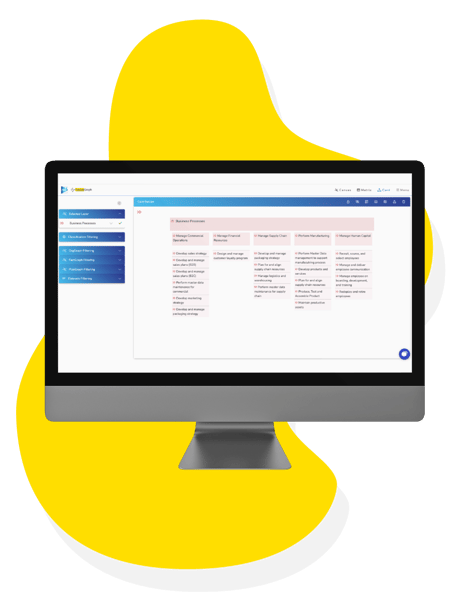
Mapping Business Processes in FusionGraph
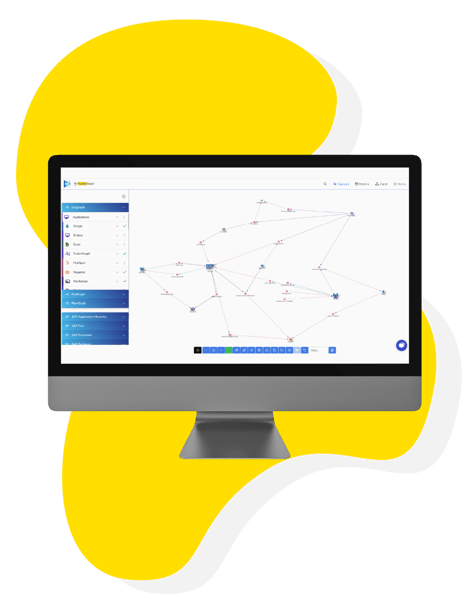
Mapping system landscapes in FusionGraph
Mapping your technical landscape in SAP ECC and beyond
In the context of S/4HANA migration we’re talking a lot about SAP systems. But in reality your ERP estate probably includes other applications – and you need to understand and map all of this to truly understand your starting point.
Your technical landscape often hides layers of complexity built up over years: interfaces that nobody remembers, custom developments for projects long forgotten, and integrations that have become fragile with age.
Phase Zero is the point where you bring all of this into the light. It’s about creating a clear, honest map of your ERP estate so you can see what’s really there and where the risks lie in both SAP and non-SAP applications – even down to the excel files that sit on people’s desktops.
This visibility helps you make informed decisions about what you should retire, what you should modernise, and what’s worth taking into your future S/4HANA landscape.
It’s not just a technical exercise; it’s about giving your business the confidence that you’re not carrying forward unnecessary baggage that will slow you down later.
Understanding SAP customisations and workarounds
Every SAP system has them: custom transactions or z-codes built to meet specific business needs, manual workarounds created to plug gaps, and processes propped up by spreadsheets and human intervention.
Over time, many of these become so embedded that they’re treated as part of “how things are done,” even if they’re slowing the business down or adding unnecessary risk.
Phase Zero is the moment to surface, challenge, and understand these customisations before your S/4HANA journey begins.
Which ones are genuinely delivering competitive advantage, and which are simply historical artefacts from a time when the system or the business was different?
By taking a clear look at your customisations and workarounds during Phase Zero, you can decide what to retire, what to reimagine, and what to protect, ensuring you don’t simply replicate complexity in your new system.
Phase Zero lets you use the move to S/4HANA as an opportunity to simplify and strengthen your business processes.
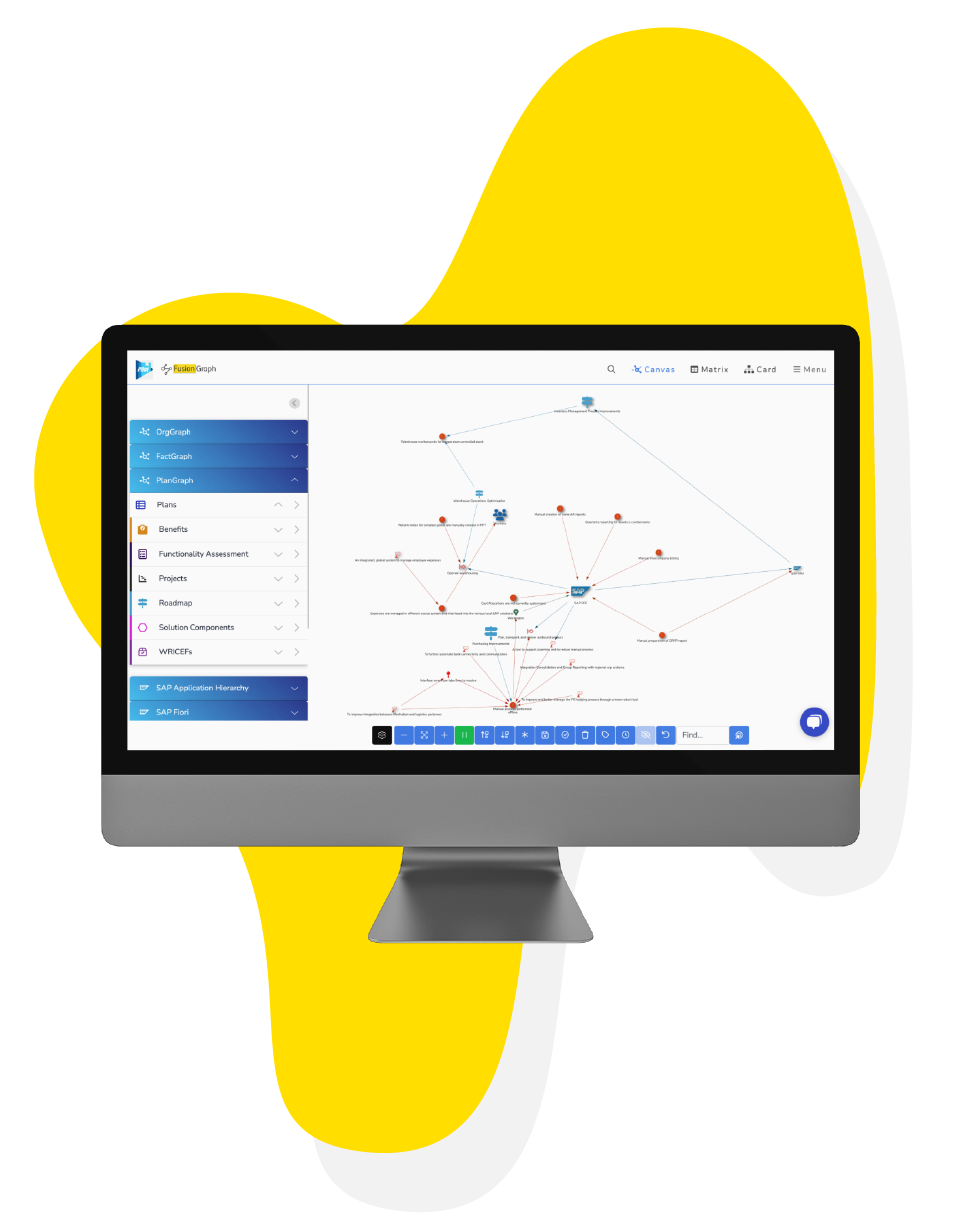
Map work arounds in FusionGraph
Usage Analysis and Data Baselining in Phase Zero
Understanding how your SAP system is used is different from understanding the data it holds—but both are critical for a successful move to S/4HANA.
Usage analysis helps you identify which transactions and processes are truly critical, which are lightly used, and which are redundant or replaced by manual workarounds.
Tools like FusionGraph can use your SAP ST03N log to map real-world transaction usage to your business process framework, showing which parts of SAP you use the most, where custom transactions are being used, and which areas of the system deliver the most value to your business.
Data baselining, on the other hand, focuses on understanding what data you have, its quality, and its relevance to your future business.
This includes assessing data volumes, cleansing needs, archiving opportunities, and compliance considerations—ensuring you only migrate what you need while reducing footprint and cost.
Phase Zero is your opportunity to gather these facts and align them with your S/4HANA business case.
By separating process usage from data readiness, you can plan your migration with evidence, reduce surprises, and build a cleaner, faster, and more cost-effective path to S/4HANA.
6. Deciding your future state during SAP Phase Zero
Use future-back thinking to align S/4HANA migration with your business strategy
One of the most powerful parts of Phase Zero is using future-back thinking to shape your S/4HANA journey.
Rather than simply asking, “What can we move across from ECC?” you start by asking, “What do we want our business to look like in five years, and how can technology help us get there?”
This approach shifts the conversation from a technical migration to a business transformation, ensuring your investment in S/4HANA directly supports your strategic goals.
It helps your leadership team visualise a future state, align on priorities, and identify the capabilities needed to drive growth, efficiency, and resilience.
Future-back thinking creates energy and direction, turning your S/4HANA programme into a tool for delivering your business strategy, not just another IT project.
Designing your “To-Be” vision in during Phase Zero
Once you understand where you are today, the next step in Phase Zero is deciding where you want to go.
Too many S/4HANA programmes kick off without a clear, shared vision of what the future should look like, leading to scope creep, misaligned expectations, and disappointment.
Phase Zero is your opportunity to build a clear, business-led “To-Be” vision, defining what your processes, data, and technology landscape should look like post-migration.
This isn’t about creating a vague wish list; it’s about agreeing on what will deliver value for your business, where you want to simplify, where you need to differentiate, and how S/4HANA will support your strategic objectives.
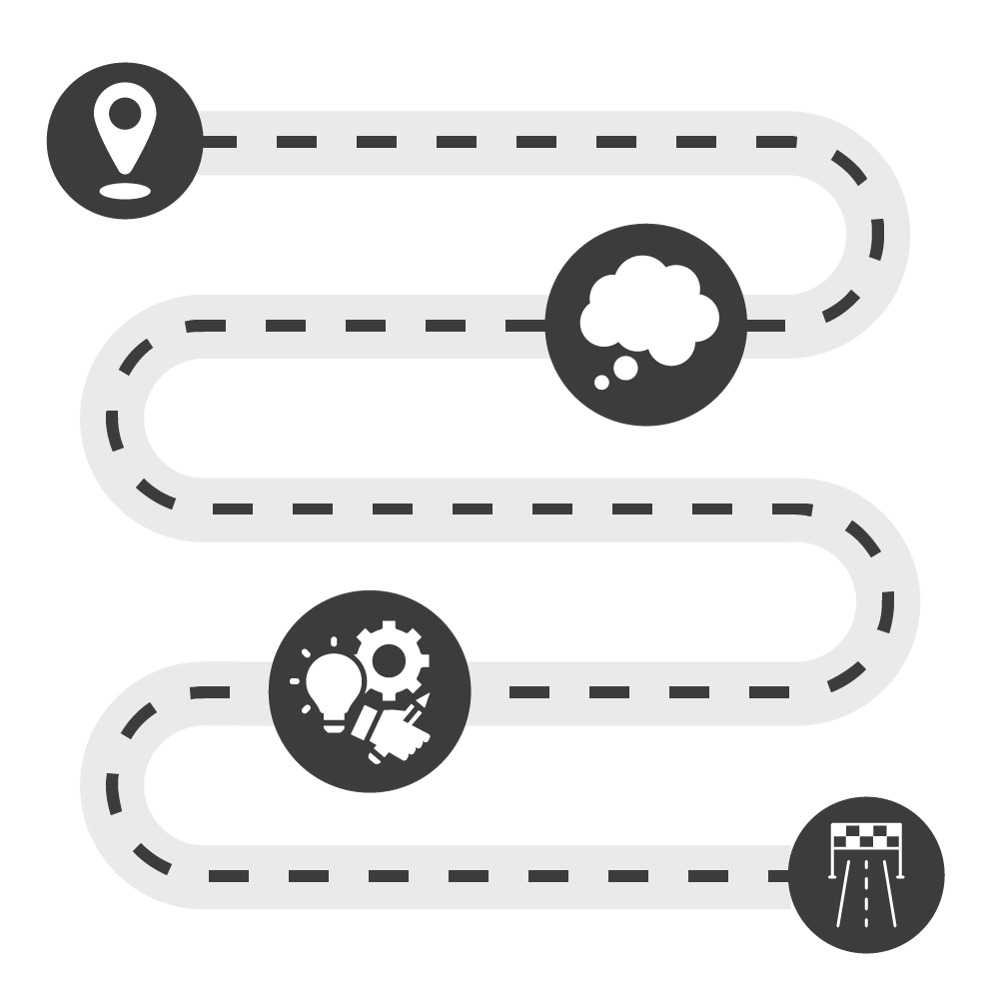

By investing the time to get this vision right, you align your leadership team, give your programme direction, and set yourself up to use S/4HANA as a platform for future growth, not just a replacement system.
But be careful. Sometimes, an attempt to design a to-be tech landscape will escalate into to full blown system design.
This is particularly common if you work with an SI on your Phase Zero.
To avoid this, it’s important to understand the difference between the two.
A solution map in Phase Zero defines the functional areas your future landscape needs to cover and where SAP, best-of-breed, or third-party tools may fit. It shows how your processes and systems could align to your strategy, helping you plan scope and sequencing without locking into detailed choices or even which software will deliver it.
It’s not system design. System design decides exactly how processes will run, which software, transactions, and apps you’ll use, and detailed configurations—work that should follow, not lead, your strategic direction.
Trying to design too early wastes effort, limits your delivery partners’ input, and can turn off good SIs during selection. Phase Zero is about setting direction and clarity, not rushing into design decisions before your programme is ready.
S/4HANA Clean core considerations during phase zero
The concept of a “clean core” is central to SAP’s vision for S/4HANA, but it often gets lost in technical jargon.
At its heart, it’s about reducing unnecessary customisations and complexity so your SAP system stays flexible, is easier to upgrade, and is ready to take advantage of future innovations.
Phase Zero is the time to explore what a clean core would mean for your business.
Which processes truly need to be different, and which can be standardised? Which customisations add real value, and which are simply carrying forward outdated ways of working? If you are going to customize, where will that customization live? In BTP, Steampunk or elsewhere like on your Azure platform?


But despite what SAP would have you believe, achieving a clean core isn’t all-or-nothing on day one.
If you’re coming from a complex and highly customised ECC system, you may choose to go live with some of this customisation in place and clean up over time.
This is why it’s better to think in terms of a “clean core journey” or a “core clean roadmap”, planning how and when you will address custom code, process variants, and simplifications as part of your longer-term S/4HANA lifecycle.
By asking these questions now, you can shape an S/4HANA environment that supports agility and future growth, rather than replicating yesterday’s complexity in a new system.
It’s about setting yourself up to move faster, innovate sooner, and keep your SAP investment aligned with your business strategy.
Preparing for AI and Innovation in Your S/4HANA Journey
Phase Zero isn’t just about preparing for S/4HANA; it’s about ensuring your move positions you to take advantage of new technologies that can drive your business forward.
While S/4HANA is important, it will always primarily be your system of record, providing the stable, reliable backbone for your business operations.
But you can’t drive all the innovation and competitive advantage you need in S/4HANA alone.
This is where pace layering comes in.
Phase Zero is your chance to plan how your future S/4HANA environment will work alongside systems of differentiation (processes and industry capabilities that make you unique) and systems of innovation (AI pilots, advanced analytics, and new digital services).
By understanding this layered approach, you can position your S/4HANA system as the platform for transformation—enabling the agility and innovation your business needs without compromising stability.
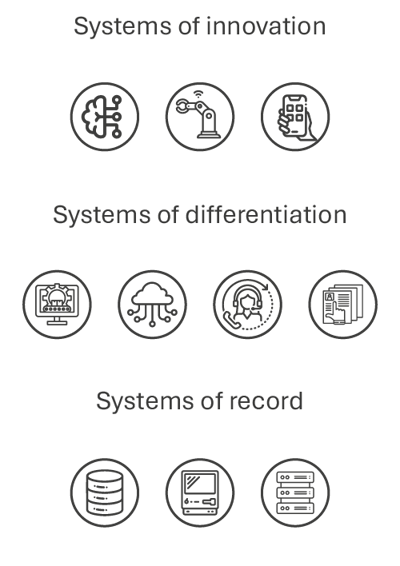

Whether it’s harnessing AI for predictive insights, leveraging advanced analytics for better decision-making, or using the flexibility of cloud infrastructure to scale and adapt, these opportunities need to be considered upfront.
Too often, businesses treat these capabilities as afterthoughts, missing the chance to design a future-ready SAP environment from the start – or focus solely on them as the silver bullets to all their problems without considering the data and infrastructure they’re built on.
Phase Zero creates the space to explore how these technologies fit into your strategy, identifying where they can add value and how your S/4HANA programme can enable—not hinder—your innovation ambitions.
It’s about ensuring your technology choices align with your business goals, so you’re not just ready for go-live, but ready to innovate and transform as your business evolves.
7. Why Licensing Deserves Its Own Space in Phase Zero
Licensing might not feel as tangible as processes or systems during Phase Zero—but ignore it, and it will catch you later. Unlike other areas of your programme, licensing transcends both your as-is and to-be states. It affects how you baseline today, how you design tomorrow, and how you negotiate every step in between.
Start with a License Audit
Before you think about your future licensing model, you need to get clear on what you’ve already bought—and what you’re really using. Reviewing your Bill of Materials (BoM) isn’t just housekeeping; it’s how you uncover shelfware, duplication, and hidden risks from indirect access. Many organisations assume their BoM reflects reality. It rarely does.
A proper license audit during Phase Zero should include:
- Reviewing all existing contracts, clauses, and entitlements
- Mapping actual system usage to licenses held
- Identifying shelfware and under-utilised assets
- Uncovering risks tied to indirect access and third-party integrations
This gives you a factual starting point for negotiation, planning, and avoiding unnecessary future cost.
Bring Licensing into System Design Conversations
Licensing isn’t just a legal or procurement issue—it’s a design consideration. The architecture choices you make today will define how you’re charged tomorrow. Consider licensing impacts alongside your clean core ambitions, data flows, and technology architecture to avoid costly surprises later.
Rethink Your Procurement Strategy
Moving to S/4HANA is the perfect opportunity to regain control of licensing. Don’t let SAP—or your Systems Integrator—dictate the pace or timing of your procurement conversations. The timeline is yours to control. Phase Zero is when you assess whether subscription, consumption, or perpetual models best serve your future operating model—and how deployment choices (RISE, GROW, private cloud, on-prem) impact your options.
Remember: licensing is a negotiation, not a foregone conclusion. Your future requirements should drive procurement, not the other way around.
Design Your Future Licensing Landscape
Your future licensing strategy isn’t just a procurement exercise—it’s part of your future operating model. How you design your systems will directly impact how you’re licensed in the future. Consider how document flows, system integrations, and process design influence licensing costs, especially for areas like:
- Digital Access: How many systems will create documents in SAP?
- Document Posting Volumes: How will future processes affect your entitlements?
- BTP Consumption: How will you monitor and manage usage to control costs?
- AI & Innovation Layers: How might consumption-based licensing models evolve as you innovate?
These decisions can significantly alter your cost profile. Phase Zero is your chance to design a future landscape that supports your business goals while managing risk and cost.
The Bottom Line
If you want your S/4HANA programme to be successful, treat licensing with the same strategic rigour as processes, data, and systems. It cuts across every stage of your journey—from as-is to to-be—and deserves a place at the table from the start.
8. Quantifying your S/4HANA business case
Once you have a clear narrative and understand your current landscape, Phase Zero allows you to develop a robust, evidence-based business case that goes beyond fear-based justifications.
Using your as-is to quantify cost and risk
Through your as-is analysis, you gain a clear picture of the true cost of maintaining your existing landscape, uncovering the technical debt, inefficiencies, and workarounds that drain resources and slow your teams down.
You also reveal the risks tied to legacy systems, from security vulnerabilities to support challenges, along with the hidden costs buried within processes that are no longer fit for purpose.
This understanding becomes the baseline against which improvements can be measured and the starting point for articulating the benefits your business will achieve through a move to S/4HANA, turning abstract ambition into measurable opportunity.


Using your future state to identify value drivers
As your future-state vision takes shape during Phase Zero, it becomes clearer how S/4HANA can deliver tangible value for your organisation.
You begin to see the opportunities for process efficiencies that will reduce manual work and rework, as well as the improvements in data visibility and real-time insights that can support faster, better decision-making.
Your future state also highlights the capabilities that will enable your business to innovate, explore new business models, and enhance customer experiences.
It shows how a modern SAP landscape can become the foundation for leveraging AI, advanced analytics, and composable services to stay competitive in a fast-moving market.
By connecting these opportunities to your business’s metrics and priorities, you start to quantify the potential benefits of your S/4HANA investment, translating your strategic ambitions into a credible, measurable case for change.
Building a realistic, credible model with ROM costing
Phase Zero is the time to test your assumptions, validate your numbers, and refine your business case in a way that will stand up to scrutiny.
This is when you bring the wider business into the conversation early, ensuring your approach to financial modelling aligns with how your business measures value and risk.
It is also the stage to introduce ROM (Rough Order of Magnitude) costing, giving your leadership team an early sense of likely costs and timelines while maintaining flexibility and avoiding false precision.
This helps frame expectations realistically and enables your teams to explore different scenarios with confidence, testing best-case, worst-case, and most likely outcomes to see how your business case holds up under different conditions.
By using ROM costing and scenario planning during Phase Zero, you give your leadership the confidence that your S/4HANA investment decision is informed, realistic, and aligned with the realities and ambitions of your business.


Moving from business case narrative to value based numbers
As Phase Zero progresses, your business case evolves.
It shifts from a compelling narrative into a well-supported, quantified case that demonstrates why it makes sense for your business to act.
This shift brings clarity and confidence to your executive team, positioning your move to S/4HANA as a transformation that will create value rather than simply add cost.
It ensures that funding discussions are grounded in a realistic, evidence-based view of potential return on investment and the benefits your business will gain from the transformation.
At this stage, you can also outline the key performance indicators (KPIs) you will use to track success and outline your approach to benefits tracking and value realisation.
Doing this during Phase Zero ensures your business case is not just a static justification for investment but a living tool that will guide your programme, measure outcomes, and help keep your teams focused on delivering value.
By the end of Phase Zero, your business case should stand as a robust, credible document that aligns with your strategic objectives, resonates with your stakeholders, and equips you to move into your S/4HANA journey with confidence and purpose, ready to deliver measurable outcomes rather than simply reacting to deadlines.
9. Program planning and migration strategy in SAP Phase Zero
Migration approach options (brownfield, greenfield, and bluefield)
Choosing how to move to S/4HANA is one of the biggest decisions you’ll make in your transformation journey.
Brownfield, greenfield, and selective data transition or bluefield each offer different benefits and risks, but too often these choices are made without the context of your business goals, current landscape, or readiness for change.
Phase Zero is where you explore these options objectively, aligning your migration strategy with your business priorities, technical realities, and appetite for change.
It allows you to understand the implications of each path, weigh up cost, risk, and opportunity, and make an informed decision about how to move forward in a way that sets your programme up for success rather than regret.
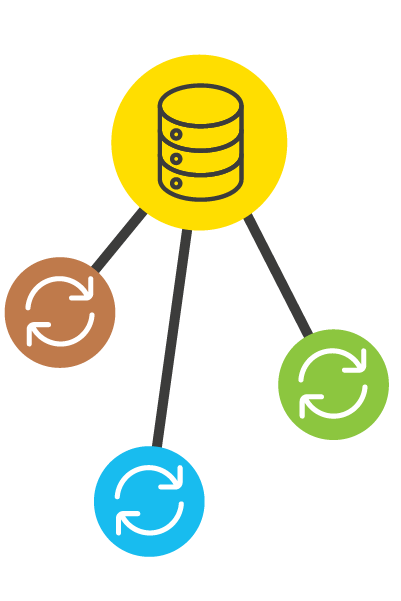
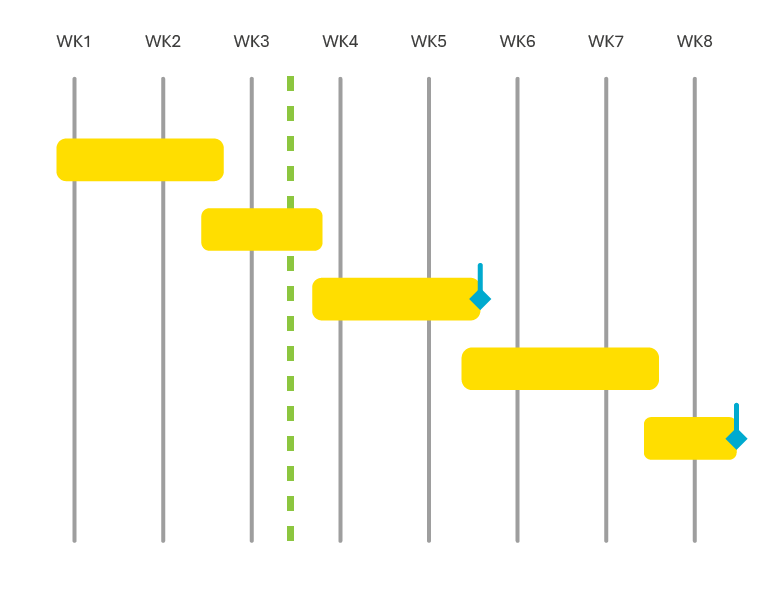
Sequencing and roadmap planning in Phase Zero
A successful S/4HANA programme isn’t just about what you do, but the order in which you do it.
Poor sequencing leads to rework, confusion, and unnecessary cost. Phase Zero is your opportunity to build a clear, realistic roadmap that aligns with your business priorities and resource availability.
It helps you identify quick wins that build momentum, critical dependencies that need addressing first, and logical phases that spread risk and investment sensibly.
This isn’t about creating a rigid plan set in stone but about building a flexible, informed roadmap that gives your leadership confidence and your teams clarity as they navigate the journey to S/4HANA.
Planning data and custom code remediation for S/4HANA
Data and code are often the hidden weights that slow down S/4HANA programmes.
Years of accumulated data, much of it unused, and layers of custom code can turn your migration into an exercise in complexity if left unchecked.
Phase Zero is your chance to get ahead of these challenges.
It’s about understanding what data you have, what you actually need, and what can be archived or cleaned before migration.
Similarly, it’s the point where you assess your custom code, identifying what adds genuine business value and what can be retired.


By tackling these topics early, you reduce risk, lower costs, and simplify your path to S/4HANA, ensuring you don’t carry forward unnecessary baggage into your future system.
A key part of Phase Zero is exploring the solutions available to you to mitigate these challenges and getting independent advice to explore the entire market.
SI’s love task like these remediation as it means they can sell large offshore program teams to manually work through your data and code in preparation for S/4HANA.
In reality there are a number of software tools that can massively accelerate this process.
Where it’s automating code remediation or historizing your data so you can easy access it from your new S/4HANA system without having to move it across – working with an independent advisor to get a full market scan of the accelerators and tools to support your migration can have a significant impact on your implementation.
10. Software and partner selection in SAP Phase Zero
The SAP SI partner landscape for S/4HANA
Selecting the right implementation partner can make or break your S/4HANA programme, yet many organisations rush this step without fully understanding the partner landscape.
The big SIs, niche consultancies, and independent advisors each bring different strengths, approaches, and commercial models.
Phase Zero is the time to explore and understand these differences, clarifying what you need from a partner based on your size, complexity, internal capability, and culture.
It’s about building a clear view of who is out there, what they offer, and how their approach aligns with your priorities—so you can make an informed choice that supports, rather than derails, your S/4HANA journey.


For example, if you opt for a brownfield technical migration one of the offshore pure-play SI’s might be your perfect partner.
However, if you’re going greenfield and using S/4HANA migration as an opportunity for digital transformation, you need an SI with a mature people and change management capability along side the technical skills.
Or perhaps you will have a mixture of partners – one focussing on technology and one focussing on business transformation.
Working with an independent advisor can provide you with the deep knowledge of the SI market that you need to make the right choice for your business and your migration.
Preparing a high-quality RFP during Phase Zero
A rushed or vague RFP often leads to poor partner fit, unclear expectations, and a rocky S/4HANA implementation.
Phase Zero is your chance to prepare a high-quality RFP that reflects your true business needs, your current and future state vision, and your readiness to engage with a partner.
It’s about going to market with clarity, so you can attract the right partners, secure meaningful, comparable proposals, and avoid surprises later.
A strong RFP sets the tone for your programme, establishing the outcomes you want, the way you want to work, and the standards you expect—ensuring your partner selection becomes a deliberate, strategic step rather than a hurried checkbox exercise.


The clean room approach in S/4HANA Phase Zero
The clean room approach is an additional step in partner selection that we highly recommend.
It’s designed to create a safe, neutral space for detailed dialogue between you and potential systems integrators (SIs).
It allows you to clarify, validate, and refine assumptions, requirements, and future-state designs in a transparent and collaborative environment — without the commercial pressures of procurement influencing the conversation.
Clean room sessions typically take the form of intensive, face-to-face workshops between your program team and the people from the SI that they propose would work on your migration.
It allows both parties to talk through key assumptions and scope items in detail.
This process gives both sides an opportunity to test thinking, resolve uncertainties, and better understand the real implications of proposed approaches on cost, complexity, and delivery risk.
By taking your future-state hypotheses — shaped through the broader Phase Zero activities — into these sessions, you’re able to pressure-test your plans against real-world delivery experience and gain deeper insight into how each potential partner would behave and engage during the actual program.
It's about more than just clarifying scope; it’s about understanding the cultural and practical fit of each partner. And you’ll often leave the sessions with a strong emotional or gut feeling about which partner is the right fit for you.
It can be hard to quantify, but this emotional response from your program team should be given considerable weight, as they’ll be working alongside your future partner for the next year or more.


Following these sessions, SIs are typically invited to revise and sharpen their proposals through a Best and Final Offer (BAFO) process. This often results in more accurate, defensible costs and commitments, rooted in genuine shared understanding rather than guesswork or assumptions.
Ultimately, the clean room approach reduces risk, helps you enter commercial negotiations from a position of clarity and strength, and ensures that your partner selection is based not just on a written proposal, but on evidence of how each candidate operates when challenged.
It’s a powerful tool for maintaining control of your S/4HANA journey, ensuring your project begins on solid, well-understood foundations.
Engaging SAP constructively while remaining independent
Engaging SAP early in your journey can be valuable, but it’s crucial to do so while maintaining your independence.
SAP will naturally want to steer you towards its timelines and commercial goals, which may not always align with your business needs.
Phase Zero gives you the structure and clarity to engage SAP proactively, asking the right questions and gathering the information you need without losing control of your agenda.
It’s about using the relationship to your advantage—understanding licensing options, product roadmaps, and best practices—while ensuring your decisions remain driven by your business strategy, not just SAP’s sales objectives.
This balance allows you to leverage SAP’s expertise without compromising your independence as you prepare for your S/4HANA journey.

Conclusion: Why SAP Phase Zero is critical
Phase Zero isn’t just a nice-to-have; it’s what separates successful S/4HANA programmes from those that overrun, underdeliver, or lose the confidence of the business.
It gives you the time and structure to understand your current landscape, define where you want to go, and align your teams around why you’re making the move.
It turns a reactive, deadline-driven migration into a proactive, business-led transformation, ensuring you’re making the right decisions with the right people, at the right pace, for the right reasons.
Independence vs. SI-led approaches in Phase Zero
Who drives your Phase Zero matters.
When it’s led by an SI, there’s a risk the process becomes shaped by their methodology, preferences, and commercial incentives rather than your business needs.
An independent Phase Zero keeps your priorities front and centre, giving you space to define your requirements, understand your landscape, and build your roadmap before committing to a partner.
It allows you to engage with SIs from a position of clarity and strength, ensuring you retain control of the agenda and that your S/4HANA programme is shaped around your strategic goals, not just the path of least resistance.
Building clarity and certainty before committing to S/4HANA
Phase Zero is about creating clarity and certainty before you step into a major transformation.
It ensures you understand your current landscape, have a clear vision for your future state, and know what’s required to get there.
It aligns your stakeholders, secures executive buy-in, and builds a credible business case grounded in your strategic objectives.
Instead of moving to S/4HANA because you feel you have to, Phase Zero allows you to move because you’re ready, with a plan that makes sense for your business.
It’s the difference between hoping your programme will deliver value and being confident that it will.
Ready to start your Phase Zero with Resulting IT?
S/4HANA is one of the biggest investments your business will make in the next decade.
Doing it right starts with Phase Zero—and having the right independent advisor at your side makes all the difference.
At Resulting IT, we don’t sell licenses or implementation services, so we’re free to focus on what’s right for your business, helping you bring clarity, certainty, and control to your S/4HANA journey before you commit to a partner.
If you’re ready to start your Phase Zero with a team that puts your business first, let’s talk.
Complete the form below to get started.









